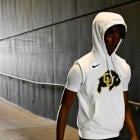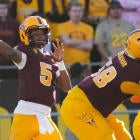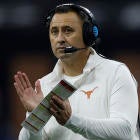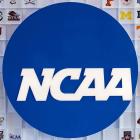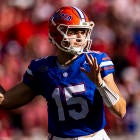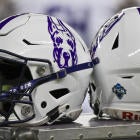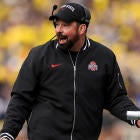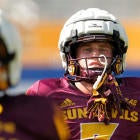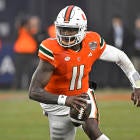OAKLAND, Calif. -- A provision from the current Big 12 and Fox television agreement appeared on the courtroom monitors. No dollar figures were shown.
Yes, TV money is ultimately what the Ed O’Bannon trial is about these days. But that's not why the TV contract was on the screen.
What it was about -- and presumably it's in part why the Big 12 unsuccessfully attempted to seal the contract -- dealt with a "Grants of Rights" provision. Under the clearance section, the following statement was shown from the Big 12 and Fox contract signed in 2011:
"The Conference shall be solely responsible for securing all clearances with respect to all officials and other persons participating in or otherwise connected with each Event, and such clearances shall include FOX having all rights or consents necessary or contemplated for the exercise of their rights under this Agreement, including, without limitation, all name and likeness rights of all participants, officials, competing teams and any other persons connected with the Events that are reasonable or necessary for the Telecast of the Events and the promotion and advertising thereof."
One word in there -- "rights" -- turned the fourth day of the O’Bannon vs. NCAA trial into a crucial debate in the case. Do college sports TV contracts convey the names, images and likenesses rights of the players, or do those rights not even exist in the first place?
The answer U.S. District Judge Claudia Wilken ultimately decides about name, image and likeness could not only establish new case law, but also allow for players to share in the billions of dollars accumulated through television in the college sports industry. Name, image and likeness -- or NILs, as they're commonly called -- is the right of an individual to control the commercial use of his or her identity.
The NCAA contends it's not necessary for the association and conferences to acquire NIL rights because athletes don't legally possess such rights. The plaintiffs say language such as what was shown in the Big 12/Fox agreement -- plus CBS/Turner deals for the NCAA Tournament and a Fox contract for the BCS -- clearly conveys those rights.
The issue took a confusing turn when NCAA TV expert Neal Pilson, a sports media consultant and former president of CBS Sports, testified there is a difference between NIL and NIL rights.
The plaintiffs showed a deposition from Pilson in which he said that even without specific language, NIL rights are part of broadcast agreements. Pilson said Thursday he meant in his deposition that NILs are part of a telecast, not that those rights for players are conveyed in TV agreements with the NCAA and conferences.
"I'm not persuaded of any transfer of NIL rights," said Pilson, adding that in his 40 years in the media industry he has never been involved with negotiations over the grant, transfer or license of participants' NIL rights.
At one point in his testimony, Pilson said he had not noticed the word "rights" in the Big 12 contract. "You're highlighting rights that I hadn't been before," he said. "Sometimes that term is used, sometimes it's not used. It's never a negotiated item."
Ed Desser, the plaintiffs' TV expert and a sports media consultant, testified that the terms in the contracts mean the telecaster has received the right to broadcast the NILs of participants, including players. NCAA attorney Kelly Klaus challenged Desser about whether obtaining NILs are "reasonable or necessary" for the telecast, as the Big 12/Fox terms stipulated. Desser, former president of NBA TV, said NILs meet both criteria.
"It does say rights of all participants specifically," Desser said. "It does say the conference is responsible for securing them. It's really left to the conference to figure it out. They've got to go off and do that and satisfy Fox that it has been done to Fox's satisfaction."
Desser agreed that he could not recall a time in his 37 years of negotiating contracts in which a broadcaster asked about permission for use of participants' NIL rights. It's common for that discussion not to occur since warranty and indemnification clauses in TV contracts guarantee the telecaster that the conference or NCAA has all of the rights needed for broadcasts, Desser said.
NIL or NIL rights?
The crux of the O’Bannon antitrust lawsuit is that two markets -- the college education market and the group licensing market -- have allegedly been harmed by fixing college athletes' pay for their NLIs at zero. Wilken has previously said that for the plaintiffs to establish the existence of a group licensing market, they must show that athletes would have NIL rights in live broadcasts and archival footage.
After court on Thursday, O’Bannon attorney Michael Hausfeld said the only confusion over the difference between NIL and NIL rights resides with Pilson and the NCAA.
"They're trying to avoid the athletes have rights in their NIL and those rights are valuable," Hausfeld said. "Otherwise, why is anyone concerned about getting them? Why is anyone concerned about commercializing them?"
NCAA chief legal officer Donald Remy tried to explain the difference between NIL and NIL rights.
"The distinction is when you're talking about the face of an individual, yes, you're talking about the face of that person, or the likeness of that person, or if you know their name," Remy said. "When you're talking about an actual right, it's a legally recognizable right that does not exist. What the plaintiffs are trying to create is a right where one historically and legally has not existed."
The NCAA argued that many states, including California, have no NIL rights under state law. The NCAA's point: If there are no such legal rights, then those rights are not being transferred in TV contracts.
Hausfeld maintained the plaintiffs don't have to overcome that legal question over state law. He cited testimony by Pilson that while at CBS he acquired the NIL rights of two tennis players.
"Nobody paid attention to what state they were in or what country they were in," Hausfeld said. "The NIL rights of the athletes have a value marketwise whether or not there may be a law that says, no, there isn’t one. That's the purpose of the indemnification [in contracts]. The indemnification says, 'I may not be perfectly comfortable with whatever that law says, so you indemnify me in the event I'm wrong.' "
Previously in the case, NCAA expert and Nobel Prize economist James Heckman said in his deposition that college athletes sign a contract that "basically appropriates or gives the university or the college the right to his names, likeness and image, that he forfeits the right to that and such contracts are common among individuals in these Division I conferences." Hausfeld said the NCAA is attempting to strike Heckman's statement from the record because he was confused about the subject.
Remy said one of the confusing parts of the case is that, yes, NILs are used in live broadcasts, but no, there's not a court that has upheld NILs as a right nor is it how the media industry operates. A current athlete has the right to sell his or her NIL, but as "amateurs" they cannot do so under NCAA rules, Remy said.
'How does the picture look with an empty uniform?'
In recent days, several TV networks and conferences had attempted to have their agreements sealed. CBS filed a motion seeking to intervene to keep its current NCAA Tournament contract sealed.
At the start of trial Thursday, a CBS attorney appeared and said the parties had reached a settlement about revealing terms of the contract. Desser, the plaintiffs' TV expert, was allowed to read from and testify about the NCAA Tournament contract, but it was not shown on monitors for the courtroom audience to see. Desser said the contract includes language confirming that CBS and Turner’s use of images "doesn't violate any statutes of the rights of participants."
O'Bannon attorney Seth Rosenthal asked if anything in the contract leads CBS and Turner to believe it doesn't have the rights of participants. Desser replied no.
The NCAA tried to tie NIL rights to promotional activities. Pilson testified that the "overwhelming" number of the 50 to 70 contracts he reviewed for the case expressed that NILs for participants were related to promotional and commercial endorsements, although "some agreements contained more extensive language."
Pilson said there is "intangible" value to promotional rights that are covered in overall rights fees. Desser said that promoting events with players often is very important so viewers will watch the games. (Past court documents showed Pilson made $825 per hour on the case and Desser charged $10,000 per day.)
Bill Isaacson, a lawyer for the plaintiffs, presented Pilson with an advertisement for the Pac-12 Tournament that showed actual players and the logo of a sponsor.
"If you take that uniform off and you have the same picture, you have a very ineffective picture," Pilson said.
Countered Isaacson: "How does the picture look with an empty uniform?"
The NCAA continued to say that broadcasters pay not for the rights to show games, but for exclusive access to broadcast in stadiums and arenas. Desser said none of the contracts he reviewed mentioned access to facilities hosting the events.
Given the NCAA exclusive access argument, Isaacson asked Pilson how it is that visiting teams have broadcast rights. Pilson said a legal case many years ago settled that question so visiting teams couldn't refuse to play on television, but could negotiate a fee.
The plaintiffs also spent considerable time questioning Pilson's belief that public perceptions of college sports would significantly change if players were paid. "I think Alabama football fans would follow their team win or lose, pay them or not," Pilson said in the first of a couple instances in which he suggested there's a marketplace for players to be paid. "That's not the audience I'm (worried) about."
Pilson said there would be no television event if Texas and Oklahoma took off its uniforms and played with green and blue jerseys. "Let's say the Boston College basketball team will share revenues from TV and lo and behold, each member of a basketball team is entitled to $200,000," Pilson said. "I just think that's a negative for the public."
Isaacson pressed Pilson on whether there's a lower dollar amount with which he would feel comfortable. "I think it would depend on which team and how the money is allocated or decided," Pilson said. "I'd tell you $1 million would trouble me and $5,000 wouldn't. That's a pretty good range."












